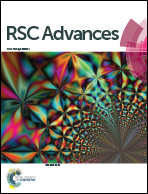Cobalt oxide nanoparticle embedded N-CNTs: lithium ion battery applications†
Abstract
Cobalt oxide embedded nitrogen-doped carbon nanotubes (CoO/N-CNT) are synthesized by the direct carbonization of a cobalt–benzimidazole framework (ZIF-12) at 950 °C under an inert atmosphere. X-ray photoelectron spectroscopy indicates the conducting graphitic networks of the CNT contain edge and aromatic substituted pyridinic-nitrogen. Microscopy reveals the extensive formation of multi-walled CNT encasing CoO nanoparticles. This trapping of CoO nanoparticles within the nitrogen doped CNT network is discussed as the key basis of improving the material's contact resistance and conductivity to achieve high power outputs, together with the high specific surface area (365 m2 g−1) and structural robustness of the novel composite material. The material shows an excellent lithium charge/discharge and storage, retaining ∼95% capacity after 50 cycles and a reversible capacity of ∼1100 mA h g−1 at a current density of 0.1 A g−1, which far exceeds the performance of conventional lithium ion battery anode materials under similar conditions.


 Please wait while we load your content...
Please wait while we load your content...